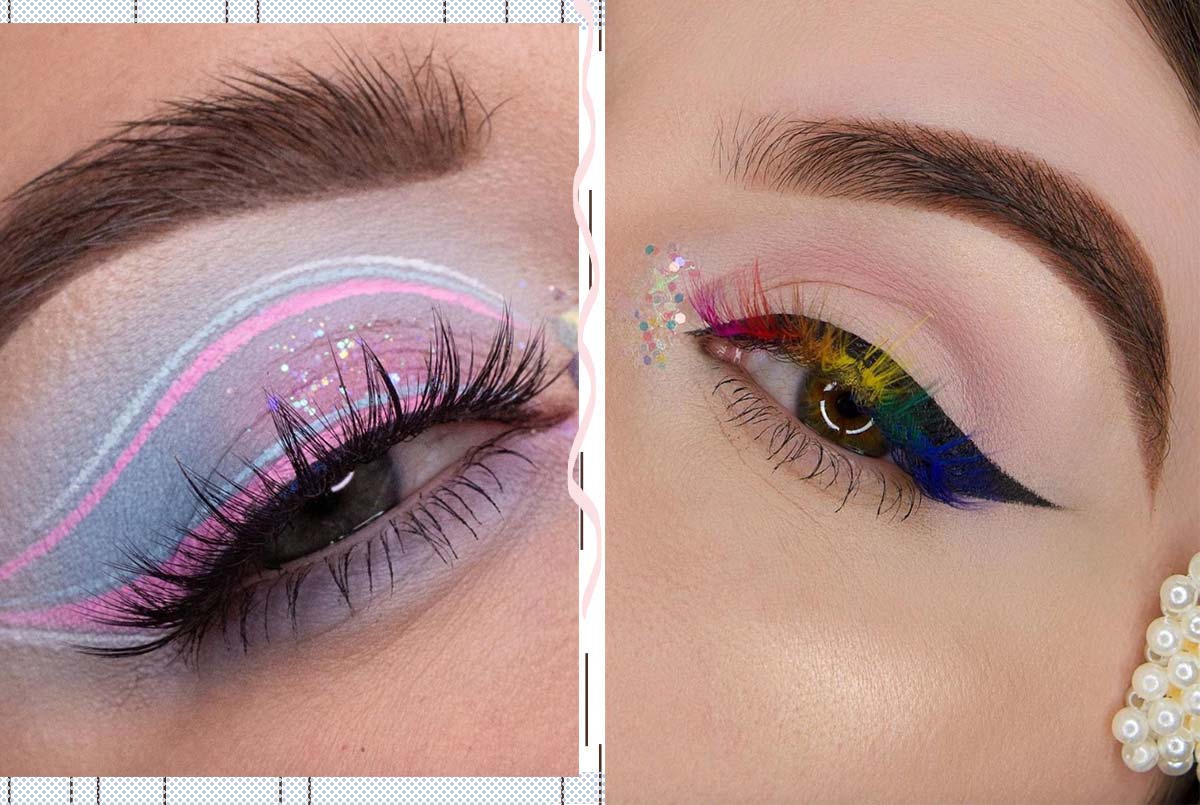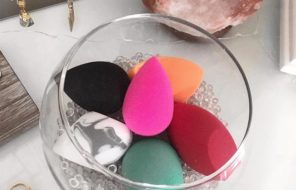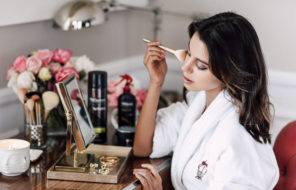The world of false eyelashes has grown a lot in just a few short years. We’re way past the days of plastic-y falsies. These days, false lashes are lush and luxurious, with a few formats beyond the old-school strip. Keep reading to learn what they are!
In this article:
- Strip Lashes
- Demi or Half-Lashes
- Cluster Lashes
- Individual Lashes
- Bottom Lashes
- Magnetic Lashes
- Fantasy Lashes
- What Are False Eyelashes Made of?
- False Lashes vs. Lash Extensions
Strip Lashes
Strip lashes are the classics, of course. With a strip lash, the little lash-like fibers are attached to a plastic band that fits right up against the lash line. They’re most people’s favorites because they’re relatively easy to pop on, and they bring instant drama.
Strip lashes come in all kinds of shapes and sizes, and they can be made of different materials, as well, like synthetic silk, mink, plastic, or human hair.
Demi or Half-Lashes
Demi-lashes are basically half or a third of a strip lash. Instead of covering the entire lash line, they only cover a part of it. They’re usually applied along the outer part of the lash line to give the eyes a lifted look.
Because they don’t touch the inner corner of the eyes, half lashes are usually a lot more comfortable than strip lashes. They’re also easier to apply, so they’re a great choice for beginners.
Read Next: How to Apply False Eyelashes Like a Pro
Cluster Lashes
Cluster lashes are a great choice if you like to get creative. They’re little lash clumps. They have a tiny drop-like base instead of a full band, to which 10-30 lash fibers are attached in a cluster.
They can be used in any number of ways, especially when they come in a pack with multiple lengths. You can apply just a few along the outer lash line, space them out along the lower lash line for a Twiggy-esque look, or use them all along the upper lash line in a customized design.
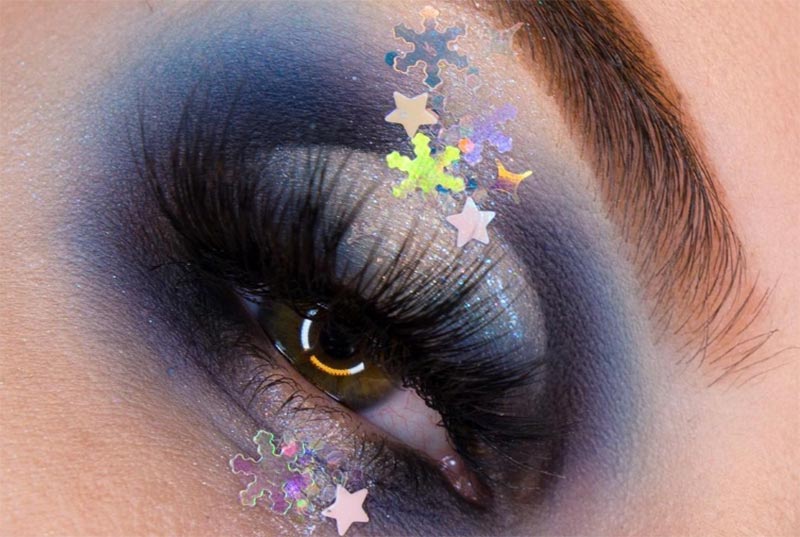
Individual Lashes
Even more intense than cluster lashes are the individual lashes. Individual lashes are basically smaller clusters of lash fibers. Usually, each “individual lash” actually consists of 3-6 lash fibers.
You glue them to your lash line, one by one, for an even more customized effect than with clusters. They’re quite labor-intensive, but the result can be very natural, and you can build a look that’s exactly what you had planned.
Bottom Lashes
Some brands have released lashes designed specifically for the lower lash line, while other brands have more subtle-looking strip lashes and demis that have become popular for the lower lash line.
Wearing false lashes on the lower lash line is a daring choice that’s usually saved for high-concept photoshoots or for unique stage looks. Lashes used along the lower lash line have to be smaller and shorter than the average strip lash since otherwise, they can look strange and spidery.
Read Next: How to Remove False Eyelashes Safely & Painlessly
Magnetic Lashes
One of the most recent innovations in the world of false eyelashes is magnetic lashes. Instead of sticking to the lash line with the help of glue, they hang on with magnets. There are two main types of magnetic lashes.
Magnetic Lashes with Eyeliner
First, there are magnetic lashes that come with a magnetic eyeliner. Their band is reinforced with little magnets, so once you apply the magnetic eyeliner, the band will stick to it in seconds, without the need for glue.
They’re actually the newer option on the market, but they’re also the better choice because they’re so easy to use. The eyeliner itself can be a little gloopy, but it usually works well if you layer it over a traditional eyeliner.
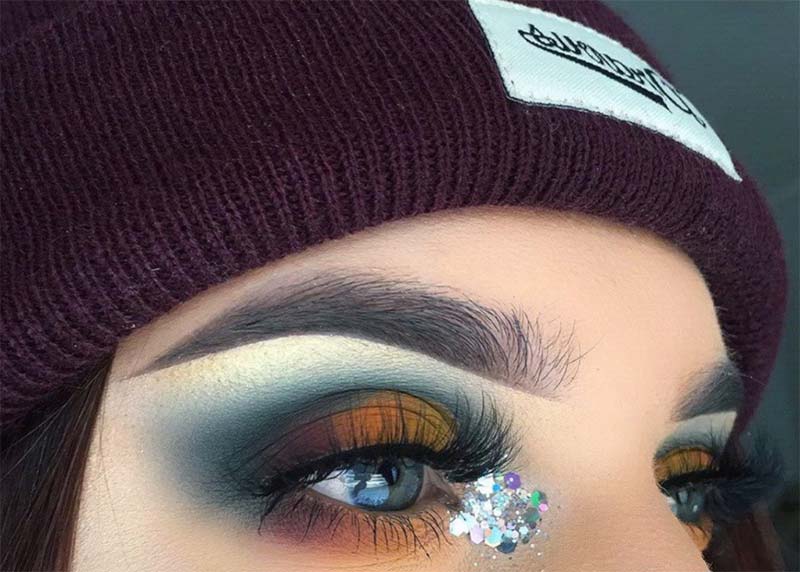
Sandwich Magnetic Lashes
The second style of magnetic lashes requires some finagling and “sandwiching,” which is why we named them thusly. They’re comprised of one set of top lashes and one set of bottom lashes, each with magnets along the base.
The top lashes go along the top part of the lash line, while the bottom lashes go below the top lashes. The two lash strips grab onto each other through the lashes, thanks to the magnets, which is how they stay in place.
Learning to use them can be difficult, and some beauty lovers may never get the hang of it. However, those who manage to make them work often fall in love with them.
Read Next: How to Choose the Best False Eyelashes for Your Eye Shape
Fantasy Lashes
Whenever Halloween comes around, fantasy eyelash sales go wild. If you’re not familiar, fantasy lashes are made to look… well, fantastical. Instead of aiming to mimic natural lashes, fantasy lashes come in dramatic shapes, colors, and materials.
Common options include glittery lashes, bejeweled lashes, or lashes made of feathers. They can be a lot of fun if you like to experiment with creative makeup.
What Are False Eyelashes Made of?
False eyelashes sometimes look so real that the only question that can come to mind is, what on earth are they made of? As it turns out, there are a few different materials that different brands choose to use.
Polyester
Nowadays, when animal cruelty and ethical sourcing are at the front of many beauty lovers’ minds, vegan lash fibers have become the standard material for most false eyelashes. Both the drugstore and high-end brands are using polyester fibers.
Now, we’re not talking about weird, tough plastic (although we’ve come across cheaper false lashes that did look like that). Polyester is actually remarkably versatile, and it can be transformed into a satiny fiber that is nearly indistinguishable from its natural counterparts. Because of this, it’s often nicknamed “vegan silk” or “faux silk,” and it results in false lashes that look incredibly soft and fluttery.
Mink
Before polyester became standard, mink was one of the more popular materials for luxury falsies. Mink fibers are incredibly soft, and historically, they were probably the most natural-looking option for false lashes, although these days, polyester gives them a run for the money.
The mink fibers in question are taken from the fuzzy little mammals of the same name, which is a practice that most animal rights activists are strongly opposed to.

Human Hair
Human hair also used to be a popular material for false lashes. Nowadays, some brands (Ardell comes to mind) still offer some human hair lashes. The hair for the lashes is usually the same kind of hair that’s used for hair extensions, so it’s clean, and it’s able to hold a curl (and lose a curl) just like human hair.
However, it’s worth noting that the individual fibers themselves are usually thicker than natural lashes since head hair can be thicker. Additionally, some people choose to avoid human-hair false eyelashes because of ethical concerns about the hair trade.
Read Next: 15 Best False Eyelashes for Every Budget
Silk – The Deceptive Material
Lastly, some brands claim to make the false eyelashes out of silk, which is an animal-derived fiber that’s made by the silkworm. In most cases, lashes aren’t really made of silk, but they’re actually made out of “faux silk” or, in other words, polyester.
If you’re a vegan and happen across false lashes that are advertised as being made of silk, a bit more research will usually uncover that they’re actually polyester.
What Is the Lash Band Made of?
The actual lash band to which the lash fibers are attached can also be made of different materials. Usually, it’s made of plastic or polyester, which is very hearty and yet flexible.
Some brands use cotton for the lash band instead, which is even more flexible, lightweight, and gentle, although it’s not as good at keeping its shape.
False Lashes vs. Lash Extensions
It’s easy to get confused between false eyelashes and lash extensions. They look similar, and the names don’t really give any hints. If you’re curious about one or the other, here’s our quick explanation.
False Eyelashes
False eyelashes, also known as false lashes, fake eyelashes, or falsies, are a one-time deal. You put them on with the help of easy-to-remove eyelash glue, and they’ll stay in place until you’re ready to take your makeup off. While the false lashes in and of themselves can be reusable, you’ll have to take them off and clean them before you can reapply them.
Read Next: Types of False Eyelashes: Different Shapes, Sizes & Materials
Eyelash Extensions
Lash extensions are a more long-lasting situation. It’s not really possible to apply your own lash extensions, so you’ll need to see a professional in a salon. The lash technician uses a more long-lasting adhesive to glue single lash fibers down along the lash line. It’s a professional service that can cost quite a bit, but the lash style itself can be totally customized. Once the lashes are on, they can stay in place for up to 6-8 weeks.
Photos via @shadesbynina, @lizannelee, Instagram

